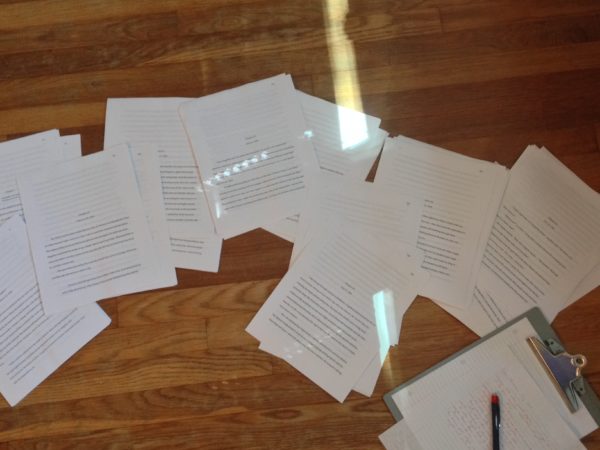 Several writers I know have employed a style of revising that I call the living-room-floor technique for revisions. It’s simple enough—take your printed manuscript and spread it out on the living room floor (or any room with enough space) and start rearranging. Move chapter five to the beginning; take a slow-moving scene and put it directly after a dramatic, hard-hitting scene; that scene you love that just doesn’t fit anymore, set it off to the side.
Several writers I know have employed a style of revising that I call the living-room-floor technique for revisions. It’s simple enough—take your printed manuscript and spread it out on the living room floor (or any room with enough space) and start rearranging. Move chapter five to the beginning; take a slow-moving scene and put it directly after a dramatic, hard-hitting scene; that scene you love that just doesn’t fit anymore, set it off to the side.
Not every novel needs this sort of rearranging. A mystery or a romance, for example, in which events have to happen in a certain order, probably wouldn’t require this revision technique. Books that are more character driven, though, especially with more than one major character, may benefit from chapters and scenes being laid out in front of you and shuffled into new orders. Unexpected connections might strike you; redundancies might become obvious.
I just employed the living-room-floor technique for the first time. My agent has been sending my book, As the Crow Flies, to editors and has consistently been getting the same response: the constant jumping between two time periods (1996 and 2008) was at times confusing, at times frustrating. I did alternate between past and present in nearly every chapter. I was careful to make the time shifts clear, and to have events in the present sometimes reflect those in the past, while events in the past shed light on present-day complications.
My agent and I discussed this complaint, and I told her I could rearrange the chapters—group more present chapters together, more past chapters together—without having to significantly rewrite anything. She agreed that I should try, and so I employed the living-room-floor technique.
As I reevaluated the flow of scenes and chapters and revelations and complications in the two time periods, I saw a different logic to how the chapters could be arranged. The first three chapters in the present comprise a twenty-four hour span of time; easy enough to keep them together. In the past, the first two chapters deal with the formation of a quartet of friends. Another easy grouping. I had to be careful—as I had been when I first wrote the book—that information is revealed in the past and present in the proper order.
Yesterday I read through the whole book. Some new transitions needed to be written; I was able to cut two lengthy scenes that weren’t essential and slowed the pace, but I also had to cut one scene that, although not essential, I really liked; and only once was I disappointed in where I had to break from the past to the present. On the whole, the living-room-technique worked well for me.
Months ago I had thought the book was done, that three rounds of extensive revisions had made Crow as good as it was going to get. And it certainly is true that a book can be overly revised, that at some point the writer has to say, “Enough. I am done with this book.” I would not have done more intrusive revisions at this stage, changes in character or plot. These revisions simply changed the manner in which the book is being told, and I’m glad I did them.
Now I can only hope there’s an editor out there who agrees.


2 thoughts on “The Living-Room-Floor Technique for Revisions”
This technique is similar to story-boarding in film. A step back, literally a different slant at too familiar material can’t hurt, just like a six month rest period may give the writer better results than “wrestling” . Good luck. Martha
this may be the magic revision. the book has so many really emotionally “true” scenes, that I do think it will find its publisher. It is interesting that the critiques were that the scenes jumped back and forth in time. I just finished Kate Atkinson’s The God in Ruins and Anthony Doerr’s All the Light We Cannot See. Both jump back and forth to many more period than yours, making me wonder if this is a new approach to fiction, or at least one that is interesting to publishers and readers at this point in time.
Best wishes for the next round! the book should be published!